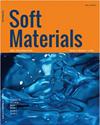Synthesis and characterization of magnetic iron oxide – silica nanocomposites used for adsorptive recovery of palladium (II)
IF 1.4
4区 材料科学
Q4 MATERIALS SCIENCE, MULTIDISCIPLINARY
引用次数: 4
Abstract
ABSTRACT Magnetic iron oxide-silica shell nanocomposites (IONP@SiO2) have been prepared in a two-step procedure. IONPs were obtained by coprecipitation of iron salts, and coated by silica in sol-gel method under sonication. Two IONP/silica ratios and two drying methods, heating in oven and supercritical CO2 drying, were used. The samples were analyzed using X-ray diffraction (XRD), infrared spectroscopy, magnetic measurements, small-angle neutron scattering (SANS), nitrogen sorption, and scanning electron microscopy (SEM) coupled with energy-dispersive X-ray analysis (EDX). The iron oxide silica nanocomposites obtained via supercritical drying exhibited higher values of the specific surface area and of saturation magnetization compared to the samples synthesized with the same iron oxide content but obtained after drying at 60 °C. Pd(II) adsorption experiments were performed on the materials prepared by supercritical drying. The maximum adsorption capacity 6.5 mg/g showed that the materials can be used as good and cheap adsorbent for palladium ions from aquatic environment.吸附回收钯用磁性氧化铁-二氧化硅纳米复合材料的合成与表征(Ⅱ)
摘要磁性氧化铁-二氧化硅壳纳米复合材料(IONP@SiO2)已通过两步程序制备。采用铁盐共沉淀法制备离子缔合物,并在超声处理下采用溶胶-凝胶法制备二氧化硅涂层。采用两种IONP/二氧化硅比例和两种干燥方法,即烘箱加热和超临界CO2干燥。使用X射线衍射(XRD)、红外光谱、磁性测量、小角度中子散射(SANS)、氮吸附和扫描电子显微镜(SEM)结合能量色散X射线分析(EDX)对样品进行分析。与用相同氧化铁含量合成但在60°C下干燥后获得的样品相比,通过超临界干燥获得的氧化铁-二氧化硅纳米复合材料表现出更高的比表面积和饱和磁化强度。对超临界干燥法制备的材料进行了Pd(II)吸附实验。最大吸附量为6.5mg/g,表明该材料可作为良好且廉价的水环境钯离子吸附剂。
本文章由计算机程序翻译,如有差异,请以英文原文为准。
求助全文
约1分钟内获得全文
求助全文
来源期刊

Soft Materials
工程技术-材料科学:综合
CiteScore
2.90
自引率
0.00%
发文量
21
审稿时长
2.2 months
期刊介绍:
Providing a common forum for all soft matter scientists, Soft Materials covers theory, simulation, and experimental research in this rapidly expanding and interdisciplinary field. As soft materials are often at the heart of modern technologies, soft matter science has implications and applications in many areas ranging from biology to engineering.
Unlike many journals which focus primarily on individual classes of materials or particular applications, Soft Materials draw on all physical, chemical, materials science, and biological aspects of soft matter. Featured topics include polymers, biomacromolecules, colloids, membranes, Langmuir-Blodgett films, liquid crystals, granular matter, soft interfaces, complex fluids, surfactants, gels, nanomaterials, self-organization, supramolecular science, molecular recognition, soft glasses, amphiphiles, foams, and active matter.
Truly international in scope, Soft Materials contains original research, invited reviews, in-depth technical tutorials, and book reviews.
 求助内容:
求助内容: 应助结果提醒方式:
应助结果提醒方式:


